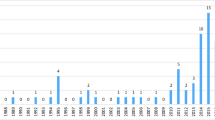Abstract
Policing in the inner-city neighborhood of Hyde Park is evaluated against a backdrop of racial polarization within the city of St. Louis and political pressures upon the St. Louis Metropolitan Police Department (SLMPD). Data garnered from immersion into Hyde Park community life, participation in and observation of numerous police/community meetings, document analyses, a focus group session with rank-and-file police officers, interviews with a sergeant and the captain of the Police Fifth District, and numerous informal conversations with residents and police officers provide evidence of poor community/police relationships. The data also provide evidence—on the part of police—of racial bias, lack of and/or poor understanding of the underlying causes of criminal behavior, pervading adventure and excitement lures toward police work, and a less than adequate understanding of the community oriented problemsolving (COPS) policing initiative. An underlying theme of little or absent informed locus of control at various levels regarding policing practices links issues of poor police/community relationships and the influence of racial bias and political pressures.
Similar content being viewed by others
References
Federal Bureau of Investigation. Uniform Crime Reports (Washington, DC.: U.S. Government Printing Office, 1995).
Ibid.
United States Department of Census (Washington DC., 1995).
Ibid.
M. Miringoff, Index of Social Health (Fordham Institute for Innovation in Social Policy, 1992).
United States Department of Census (Washington DC., 1990).
Ibid.
G. Freeman, “Racism Column Ruffled Feathers,” St. Louis Post-Dispatch, December 1993, 10, D9.
B. Bryan, “Leader of Officers Group Says Race Important in Chief Choice,” St. Louis Post-Dispatch, December 1995, 5, A4.
W. McClellan, “The Smart Money Wasn't Very Smart,” St. Louis Post-Dispatch, December 1995, 6, E1.
W. McClellan, “Mea culpa, '95: Trying to Get it Right, This Time,” St. Louis Post-Dispatch, December 1995, 31, E1.
R. Yaquib, “Funeral Procession Circles City Police Station in Protest,” St. Louis Post-Dispatch, January 1996, 13, B1.
B. Bryan, “Shootings Here by Police Top 10-City Study,” St. Louis Post-Dispatch, October 1991, 24, C1.
M. Sorkin, “Aces Got Brawler on Police Force,” St. Louis Post-Dispatch, June 1994, 5, A1.
S., Merriam, Case Study Research: A Qualitative Approach (San Francisco: Jossey-Bass Publishers, 1988).
United States Department of Census, 1990, op, cit.
Ibid.
W., DeJong and G., Goolkasian, The Neighborhood Fight Against Crime: The Midwood Kings Highway Development Corporation (New York: Office of Development, Testing and Dissemination, National Institute of Justice, 1982).
A., Podolefsky, Case Studies in Community Crime Prevention (Springfield, Ill.: Charles C. Thomas, 1983).
J., Trojanowicz, R., Trojanowicz and F., Moss, Community Based Crime Prevention (Pacific Palisades, Ca.: Goodyear Publishing Company, 1975).
H., Goldstein, Problem-Oriented Policing (Philadelphia: Temple University Press, 1990).
T., Winright, “The Perpetrator as Person: Theological Reflections on the Just War Tradition and the Use of Force by Police,” Criminal Justice Ethics, 1995 (14: 2), 37–56.
S., Messner and R., Rosenfeld, Crime and the American Dream, (Belmont, Ca.: Wadsworth Publishing, 1993).
B. Bradley, “The Real Lesson of LA,” Harper's Magazine, July, 1992.
B.R., Barber, “America Skips School: Why We Talk So Much About Education and Do So Little,” Harper's Magazine, 1993 (287: 1722), 39–46.
W.J., Wilson, The Truly Disadvantaged: The Inner City, the Underclass, and Public Policy (Chicago: The University of Chicago Press, 1987).
T., Cross, The Black Power Imperative: Racial Inequality and the Politics of Nonviolence (New York: Faulkner Books, 1987).
E., Currie, Confronting Crime: An American Challenge (New York: Pantheon Books, 1985).
W.H., Grier and P.M., Cobbs, Black Rage (New York: Basic Books, 1968).
E.O., Hutchinson, The Mugging of Black America, (Chicago: African American Images, 1990).
N., McCall, Makes Me Wanna Holler: A Young Black Man in America (New York: Random House, 1994).
Author information
Authors and Affiliations
Rights and permissions
About this article
Cite this article
Ward, C.M. Policing in the Hyde Park neighborhood, St. Louis: Racial bias, political pressure, and community policing. Crime Law Soc Change 26, 161–186 (1996). https://doi.org/10.1007/BF00227372
Issue Date:
DOI: https://doi.org/10.1007/BF00227372




